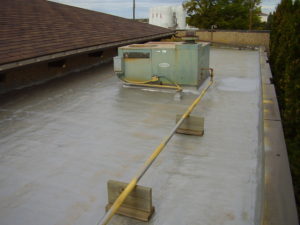There are probably as many myths as there are types of foam. Some of these misconceptions may be partly due to the fact that there are so many different kinds of foam. With about three decades of foam roofing experience we have heard some myths so absurd we won’t bother listing them here. This article is an attempt to dispel some of the most typical myths and rumors about foam roofing. Here are ten of the most common polyurethane spray foam roofing myths, listed in no particular order.

A Sprayed Polyurethane Foam Roof (SPF) installed on a Church
Myth #1: Foam Roofing is New
Although the groundwork for polyurethane foam was done by Otto Bayer and his team in 1937, polyurethane foam would not become available until much later. In 1952 polyisocyanates became commercially and commercial production of flexible polyurethane foam began in 1954, based on toluene diisocyanate (TDI) and polyester polyols. The invention of these foams (initially called imitation Swiss cheese by the inventors) was thanks to water accidentally introduced in the reaction mix. These materials were also used to produce rigid foams, gum rubber, and elastomers. As a product, polyurethane foam is over half a century old. By the late ’60’s and ‘70’s polyurethane foam had evolved into exterior roofing applications. The earliest foam roofs are now around 50 years old.
Myth #2: You can’t stop a Determined Bird from pecking a Foam Roof
A sadly deteriorating foam roof, with large patches of exposed foam (where the protective coating has worn away), then birds may peck at your exposed foam. However, it’s very easy to stop the birds from doing this. Simply replace the coating with a fresh layer or use some acrylic caulking to seal up the exposed area. Once a layer of coating covers the foam, the birds won’t bother the roof.
Myth #3: You Can’t Walk on a Foam Roof
You CAN walk on a foam roof without having the skills of those ninjas that walk on rice paper. It is best to use soft rubber sole sneakers. A foam roof is completely capable of sustaining the weight of a normal person as it can hold 50 PSI. Since a spray foam roofing structure is composed of millions of tiny closed cells, only a hole in the roof that penetrates to the underlying substrate can potentially cause a leak.
Myth #4: Foam Roofing Material is like Memory Mattress Foam
Memory foam mattresses are very low density and open cell, while roofing foam is much higher density and composed of closed cells. Polyurethane closed cell foam used in roofing applications is a completely different material composition vs memory foam.
Myth #5: Foam Roofing is Expensive
A foam roof actually costs about the same or less as a typical BUR or single ply roof and includes an R15 value at the same time. Consider that all BUR or EPDM or Asphalt roofs are all actually an oil based product. Rising oil prices are driving up the costs of most typical flat roof alternatives, while the cost of foam roofing has remained more constant. An additional benefit to consider, is that a foam roof is the last roof you’ll ever need to buy. Furthermore, a foam roof provides exceptional insulation, we use reflective cool roof coatings (on completed foam projects) which results in even further reduced energy costs. A UV reflective coating alone can cut down cooling costs by 40 percent. You won’t need to replace the foam roof in 20 years – you can simply maintain the protective coating by periodically adding re‐coats to protect the roof from prolonged UV exposure.
Myth #6: Foam Roofing is Not Durable
Polyurethane is often used in the soles of shoes due to its extreme durability. Many of the earliest foam roofs are still standing. Foam roofing has already stood the test of time, and a foam roof can last the life of your building. Our hard coat UV reflective coating is comparable to a very tough truck box liner material. We expect many years of service from this urea protective coating.
Myth #7: Foam Boards Insulate as Well as a Sprayed Foam Roof
Sprayed foam roofing is manufactured on site, and is sprayed to perfectly conform to your roof as a single monolithic barrier to the elements. A foam board roof is full of seams which allow moisture and vapour transmission, greatly reducing the insulation capacity. A sprayed foam roof seals a roof better
than any traditional material.
Myth #8: Polyurethane Foam is Toxic
Polyurethane foam materials are completely inert and safe. After the initial cure time of less than 24 hours, foam will not support mold or mildew.
Myth #9: Polyurethane Foam is not Green
New generation polyurethane foams are made with renewable resource materials such as soy meal, organic phosphates, castor oil adding to its sustainability through a safer product. There will never be any tear off, avoiding landfills. The foam reduces transportation costs due to its form as it experiences an exothermic reaction multiplying the end use product.
Myth #10: Foam Roofing Absorbs Water
The SPF used in roofing applications is “closed cell”. In other words, it is a plastic with millions of tiny closed cells which are impenetrable by water. A block of SPF submerged under water will remain buoyant and dry indefinitely. It is used in flotation docks and the hulls of sea vessels. In roofing applications, closed‐cell SPF is manufactured at the job site using specialized offshore merchant account processors pharmacy equipment, certified contractors and certified sprayers.
Summary
During the last few decades foam roofing has grown in popularity and become the flat and low slope roofing material of choice for environmentally conscious consumers. Foam roofing is truly a high quality, high performance product.
Contact Northern Spray Solutions for a quote on Spray Foam Roofing.
